Common weak bases - Study guides, Class notes & Summaries
Looking for the best study guides, study notes and summaries about Common weak bases? On this page you'll find 1432 study documents about Common weak bases.
Page 2 out of 1.432 results
Sort by

-
Test Bank for Chemical Principles, 8th Edition by Peter Atkins
- Exam (elaborations) • 558 pages • 2024
-
- $29.49
- + learn more
Test Bank for Chemical Principles: The Quest for Insight 8e 8th Edition by Peter Atkins; Loretta Jones; Leroy Laverman; Kelley Young; James Patterson. Full Chapters are included (Focus 1 to Focus 10 are included) Focus 1: Atoms 1A Investigating atoms 1B Quantum theory 1C Wavefunctions and energy levels 1D The hydrogen atom 1E Many-electron atoms 1F Periodicity Focus 2: Bonds Between Atoms 2A Ionic bonding 2B Covalent bonding 2C Beyond the octet rule 2D The properties of bonds 2...
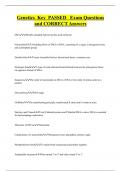
-
Genetics Key PASSED Exam Questions and CORRECT Answers
- Exam (elaborations) • 15 pages • 2024
-
- $8.99
- + learn more
DNADouble-stranded, helical nucleic acid molecule NucleotideA building block of DNA or RNA, consisting of a sugar, a nitrogenous base and a phosphate group. Double helixA pair of parallel helices intertwined about a common axis Hydrogen bondA type of weak chemical bond formed between the nitrogenous bases on opposite strands of DNA. SequenceThe order of nucleotides in DNA or RNA or the order of amino acids in a protein.
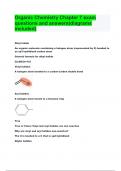
-
Organic Chemistry Chapter 7 exam questions and answers(diagrams included).
- Exam (elaborations) • 14 pages • 2024
-
- $14.99
- + learn more
General formula for alkyl halide C(n)H(2n+1)X Vinyl halides A halogen atom bonded to a carbon-carbon double bond Aryl halides A halogen atom boned to a benzene ring True True or False: Vinyl and aryl halides are non reactive Why are vinyl and aryl halides non-reactive? The X is bonded to a C that is sp2 hybridized Allylic halides Have X bonded to the carbon atom adjacent to a C-C double bond benzylic halides Have X bonded to the carbon atom adjacent to a benz...
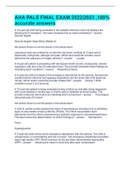
-
AHA PALS FINAL EXAM 2022|2023 ,100% accurate answers
- Exam (elaborations) • 6 pages • 2023
-
Available in package deal
-
- $20.49
- 4x sold
- + learn more
AHA PALS FINAL EXAM 2022|2023 ,100% accurate answers A 12-year-old child being evaluated in the pediatric intensive care unit displays the following ECG waveform. The team interprets this as which arrhythmia? Second degree Second Degree Heart Block (Mobitz II) the picture shown is not the picture in the actual exam Laboratory tests are ordered for a child who has been vomiting for 3 days and is diaphoretic, tachypneic, lethargic and pale. Which test would the provider use to d...
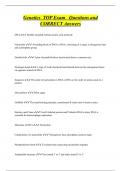
-
Genetics TOP Exam Questions and CORRECT Answers
- Exam (elaborations) • 15 pages • 2024
-
- $7.99
- + learn more
DNA Double-stranded, helical nucleic acid molecule Nucleotide A building block of DNA or RNA, consisting of a sugar, a nitrogenous base and a phosphate group. Double helix A pair of parallel helices intertwined about a common axis Hydrogen bond A type of weak chemical bond formed between the nitrogenous bases on opposite strands of DNA.
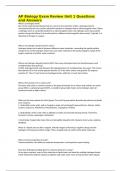
-
AP Biology Exam Review Unit 1 Questions and Answers
- Exam (elaborations) • 8 pages • 2024
-
- $10.39
- + learn more
AP Biology Exam Review Unit 1 Questions and Answers What is a hydrogen bond? One of the weak chemical bonds that are central to the chemistry of life; a hydrogen bond is characterized by the non-covalent attraction between a hydrogen and an electronegative atom. When a hydrogen atom is covalently bonded to an electronegative atom, the hydrogen atom has a partial positive charge that allows it to be attracted to a different electronegative atom nearby. Typically, it is attracted to nitrogen or ...
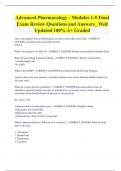
-
Advanced Pharmacology - Modules 1-5 Final Exam Review Questions and Answers_ Well Updated 100% A+ Graded
- Exam (elaborations) • 68 pages • 2024
-
Available in package deal
-
- $26.64
- + learn more
Advanced Pharmacology - Modules 1-5 Final Exam Review Questions and Answers_ Well Updated 100% A+ Graded Once you graduate from an NP program, in order to prescribe you'll need: - CORRECT ANSWER--Advanced nurse prescriber license -DEA # What is the purpose of a DEA #? - CORRECT ANSWER-Needed to prescribed scheduled drugs Rules for prescribing Schedule II drugs: - CORRECT ANSWER--Written script needed -1 month supply only -No refills What is the PDMP? - CORRECT ANSWER-Prescriptio...
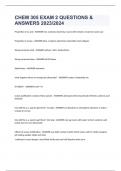
-
CHEM 305 EXAM 2 QUESTIONS & ANSWERS 2023/2024
- Exam (elaborations) • 9 pages • 2023
-
- $11.99
- + learn more
CHEM 305 EXAM 2 QUESTIONS & ANSWERS 2023/2024 Properties of an acid - ANSWER-red, conducts electricity, reacts with metal to create h2, taste sour Properties of a base - ANSWER-blue, conducts electricity, taste bitter, feels slippery Strong common acids - ANSWER-sulfuric, nitric, hydrochloric Strong common bases - ANSWER-all OH bases Weak bases - ANSWER-ammonia what happens when an strong base dissociate? - ANSWER-creates a hydroxide ion [H+]]OH]= - ANSWER-1x10^-14 ocean ...
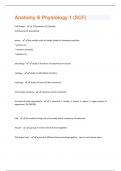
-
Anatomy & Physiology 1 (SCF) Questions and answers
- Exam (elaborations) • 16 pages • 2024
- Available in package deal
-
- $7.99
- + learn more
Cell Shapes - 1) Squamous 2) Cuboidal 3) Columnar 4) Transitional atoms - the smalles units of matter (made of subatomic particles- * protons (+) * neutrons (neutral) * electrons (-) physiology - study of functions of anatomical structures cytology - study of cells &their functions histology - study of tissues & their structures microscopic anatomy - examines cells & molecules Six levels of body organization - 1. chemical. 2. cellular. 3. tissues. 4. organs. 5. organ systems. 6. organ...

-
Chem 210 Exam 3 questions and answers
- Exam (elaborations) • 11 pages • 2023
-
Available in package deal
-
- $14.99
- + learn more
what factors explain the outcomes of reactions? hybridization, delocalization, eN, atom density what is a leaving group? - group of atom(s) that can be stable on its own - eN atoms that are good LG also make strong acids what is the α carbon? C directly attached to leaving group what are β Cs? β Hs? βC: C(s) attached to α carbon βH: H(s) attached to βC what is a LB? is it a nucleophile or electrophile? lewis base, nucleophile what is nucleophilic ...

Do you wonder why so many students wear nice clothes, have money to spare and enjoy tons of free time? Well, they sell on Stuvia! Imagine your study notes being downloaded a dozen times for $15 each. Every. Single. Day. Discover all about earning on Stuvia


